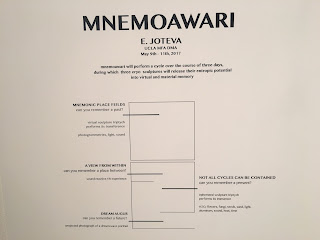DESMA 9 Week 8 Blog
Since the digital revolution began in the latter half of the 20th century with the uptick of computing and communication technology, there has been a drive to make things faster, more efficient and smaller. Scientists have now reached a new frontier, using materials on the nano-scale for technological, medical as well as artistic applications.
 |
| "Digital Revolution" http://www.jbs.cam.ac.uk/media/assets/2010_podcast_global_digital_revolution.jpg |
It was interesting to hear the history of nanotechnology from the perspective of Dr. Gimzewski, a leader in the field and a presenter at the previous event I attended: Ecocentric Art + Science Symposium: Prophesies & Predictions. He discussed the impact of Richard Feynman's daring hypothesis that there is plenty of opportunity to manipulate things on the atomic level, the discovery of carbon allotropes by Smalley et al., the invention of the scanning tunneling microscope by Gerd and Heini, self assembling DNA structures by Ned Seeman, medical applications and current controversies (Gimzewski). The discovery of graphene was particularly important due to the fact that it can potentially have applications as the new medium on which computer chips are made (Ponomarenko 356).
 |
| Carbon Allotropes http://physics.bu.edu/~neto/mother.jpg |
Of particular interest to me is Dr. Gimzewski's research on the scanning tunneling microscope. I find it so fascinating that we can manipulate atoms on an individual basis and "see" them by effectively feeling them with a needle made out of other atoms. My favorite example of this of course is the spelling of UCLA using carbon monoxide atoms.
 |
| Carbon Monoxide molecules on Copper at 5K by Lisa Welosowski http://www.ucop.edu/ott/industry/documents/Gimzewski.pdf |
This same concept has been used by IBM to make to make a movie called "A Boy and His Atom" (A Boy and His Atom). This most interesting part about his movie is the far reaching applications it has for data storage. If we can effectively encode information at the atomic level we would be able to store every single piece of information known to man into our pockets!
An additional artistic application on the nanoscale is the "toy chest" (Lilley). It illustrates the concept of self-assembly while bringing to mind a toy box children experienced when they were young. However, this discovery has more far reaching applications for medicine. This box can be used to package drugs or other nanoparticles of interest in order to transfer them across the blood brain barrier or similar boundaries. This concept has previously been shown by researchers that were able to trap a Scandium molecule within a fullerene ring (Ge).
 |
| "Toy Chest" |
"A Boy And His Atom: The World's Smallest Movie." YouTube. IBM, 30 Apr. 2013. Web. 28 May 2017. <https://www.youtube.com/watch?v=oSCX78-8-q0>.
Ge, Zhongxin, et al. "Purification of endohedral trimetallic nitride fullerenes in a single, facile step." Journal of the American Chemical Society 127.46 (2005): 16292-16298.
Gimzewski, James. "Introduction to Nanotechnology for Artists." UCLA, Los Angeles. 21 May 2012. YouTube. Web. 28 May 2017.
Lilley, Maiken. "The Art of Nanotech." PBS. PBS, 18 Nov. 2010. Web. 28 May 2017.<http://www.pbs.org/wgbh/nova/tech/art-nanotech.html>.
Ponomarenko, L. A., et al. "Chaotic Dirac billiard in graphene quantum dots."Science 320.5874 (2008): 356-358.



Comments
Post a Comment